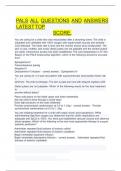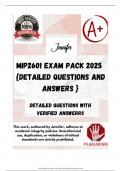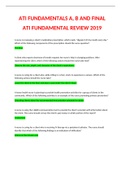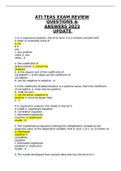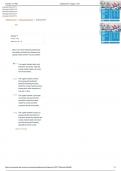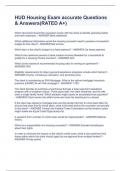LEER-
PSYCHOLOGIE
GOELE WINTERS
2 de bachelor psychologie
,Inhoudsopgave
Hoofdstuk 1 : basisconcepten en definities ..................................................................................................... 5
Wat verstaat de niet-psycholoog onder “leren”? ................................................................................................ 5
Wat zegt van dale? .............................................................................................................................................. 5
Leren in leerpsychologie ...................................................................................................................................... 5
Naar een defenitie van leren ............................................................................................................................... 6
Leren = relatief duurzame gedragsverandering .................................................................................................. 6
Leren = relatief duurzame gedragdverandering veroorzaakt door specifieke ervaringen................................... 6
Maturatie VS leren .............................................................................................................................................. 6
Leren ≠ gedragsverandering door evolutie ......................................................................................................... 6
Leren = relatief duurzame verandering in gedragspotentieel ............................................................................. 7
Niveaus van analyse “leren” ................................................................................................................................ 7
Defenitie leren (Domjan, 2018) ........................................................................................................................... 7
3 fundamentele types van ervaring ..................................................................................................................... 7
Naturalistische vs experimentele observaties ..................................................................................................... 7
Leren impliceert een causale variabele ............................................................................................................... 8
Het "fundamentele leerexperiment” ................................................................................................................... 8
Een adequate controlegroep is essentieel ........................................................................................................... 8
2 versies van het fundamentele leerexperiment (zie p. 14 dia 1) ........................................................................ 8
De “algemeen-proces” benadering ..................................................................................................................... 9
Het gebruik van proefdieren in de psychologie : voordelen ................................................................................ 9
Inadequate alternatieven .................................................................................................................................... 9
Hoofdstuk 2 : de structuur van ongeconditioneerd gedrag .............................................................................. 9
Homogeen VS heterogeen substraat van gedrag ................................................................................................ 9
Heterogeen substraat… ....................................................................................................................................... 9
Ongeconditioneerd gedrag : de reflex ............................................................................................................... 10
De reflexboog .................................................................................................................................................... 10
Componenten reflexboog .................................................................................................................................. 10
Voorbeelden “ontlokt gedrag” .......................................................................................................................... 10
Complexe vormen van ontlokt gedrag .............................................................................................................. 11
Reproductief gedrag stekelbaars....................................................................................................................... 11
Modale actie patronen (MAP) ........................................................................................................................... 11
Signaalprikkels ................................................................................................................................................... 11
1
, Signaalprikkels : voorbeeld 1 ............................................................................................................................. 11
Signaalprikkels : voorbeeld 2 ............................................................................................................................. 11
Supernormale prikkels ....................................................................................................................................... 12
Organisatie van onlokt gedrag .......................................................................................................................... 12
Hydraulisch model (LORENZ) ............................................................................................................................. 12
Appetitief en consummatorisch ontlokt gedrag ................................................................................................ 12
Appetitief-consummatorisch : voorbeeld voeding ............................................................................................. 12
Appetitief consummatorisch : voorbeeld reproductie ....................................................................................... 12
Uitbreiding ‘gedragssystemen’ .......................................................................................................................... 13
Gedragssystemen : kenmerken ......................................................................................................................... 13
Leren .................................................................................................................................................................. 13
Hoofdstuk 3 : habituatie en sensitisatie ........................................................................................................ 13
Reflexen zijn modificeerbaar ............................................................................................................................. 14
Habituatie is functioneel! De oriënteerrespons (OR) ......................................................................................... 14
Habituatie/sensitisatie visuele aandachtsrespons ............................................................................................ 14
Andere voorbeelden .......................................................................................................................................... 14
Determinanten van habituatie-effecten ............................................................................................................ 15
Determinanten van sesitisatie-effecten............................................................................................................. 16
De 2voudig-proces theorie van habituatie en sensitisatie ................................................................................. 17
Het S-R systeem ................................................................................................................................................. 17
Het toestand-systeem........................................................................................................................................ 17
Habituatie en sensitisatie-processen ................................................................................................................. 17
Habituatie en sensitisatie-processen : opponent............................................................................................... 18
De “tweevoudig-proces theorie” : implicaties ................................................................................................... 18
De tweevoudig-proces theorie : sterktes ........................................................................................................... 18
De tweevoudig-proces theorie : zwaktes ........................................................................................................... 18
De tweevoudig-proces theorie : “regulatie en homeostase” ............................................................................. 19
Excursie : de “opponente-proces theorie van emotie/motivatie” (Solomon) .................................................... 19
Opponente proces theorie : emotie ................................................................................................................... 19
Opponente-proces theorie : emotie ................................................................................................................... 20
Hoofdstuk 4 : Pavloviaanse conditionering : basisconcepten ......................................................................... 21
Pavloviaanse of klassieke conditionering .......................................................................................................... 21
De hond van Pavlov ........................................................................................................................................... 21
2
, Basistermen pavloviaanse conditionering ......................................................................................................... 21
Reductie van oorspronkelijk gegeven ................................................................................................................ 21
… en potentieel theoretisch misleidend en beperkend ...................................................................................... 21
… en potentieel theoretisch misleidend en beperkend ...................................................................................... 22
Enkele veel gebruikte klassieke conditioneringsprocedures .............................................................................. 22
Appetitieve conditionering : “autoshaping” of “sign tracking” ......................................................................... 22
Appetitieve conditionering : “autoshaping” of “sign tracking” ......................................................................... 22
Appetieve conditionering bij ratten ................................................................................................................... 23
Aversieve of vrees-conditionering : oogknipper-conditionering ........................................................................ 23
Aversieve conditionering/vreesconditionering .................................................................................................. 23
Aversieve conditionering : geconditioneerde suppressie ................................................................................... 23
Aversieve conditionering : geconditioneerde suppressie (2) ............................................................................. 24
Aversieve conditionering bij mensen ................................................................................................................. 24
Klassieke conditionering buiten het labo ........................................................................................................... 24
Vb1 : angststoornissen ...................................................................................................................................... 24
Vb2 : reproductief gedrag ................................................................................................................................. 25
Vb3 : causale oordelen ...................................................................................................................................... 25
De aard van de geconditioneerde respons (VR) ................................................................................................ 25
Autonoom vegetatieve en skeletresponsen als VR ............................................................................................ 25
Similariteit VR en OR ......................................................................................................................................... 25
Gedragssystemen en aard van de VR ................................................................................................................ 26
VP-OP interval als co-determinant van aard VR ................................................................................................ 26
Geconditioneerde modificaties OR .................................................................................................................... 27
Geconditioneerde modificaties OR .................................................................................................................... 27
Adequate controlecondities............................................................................................................................... 27
Adequate controlescondities “VP-alleen” .......................................................................................................... 27
Adequate controlecondities “OP-alleen” ........................................................................................................... 27
Adequate controlecondities “zuiver random controle” ..................................................................................... 28
Adequate controlecondities : “VP+/VP- discriminatieve controle” .................................................................... 28
adequate controlecondities “niet-gepaarde controle” ...................................................................................... 29
inhoud van leren : S-R versus S-S (wat wordt er geleerd?) ................................................................................ 29
S-R versus S-S leren ............................................................................................................................................ 29
S-R leren versus S-S leren? Effect van OP devaluatie ......................................................................................... 29
3
PSYCHOLOGIE
GOELE WINTERS
2 de bachelor psychologie
,Inhoudsopgave
Hoofdstuk 1 : basisconcepten en definities ..................................................................................................... 5
Wat verstaat de niet-psycholoog onder “leren”? ................................................................................................ 5
Wat zegt van dale? .............................................................................................................................................. 5
Leren in leerpsychologie ...................................................................................................................................... 5
Naar een defenitie van leren ............................................................................................................................... 6
Leren = relatief duurzame gedragsverandering .................................................................................................. 6
Leren = relatief duurzame gedragdverandering veroorzaakt door specifieke ervaringen................................... 6
Maturatie VS leren .............................................................................................................................................. 6
Leren ≠ gedragsverandering door evolutie ......................................................................................................... 6
Leren = relatief duurzame verandering in gedragspotentieel ............................................................................. 7
Niveaus van analyse “leren” ................................................................................................................................ 7
Defenitie leren (Domjan, 2018) ........................................................................................................................... 7
3 fundamentele types van ervaring ..................................................................................................................... 7
Naturalistische vs experimentele observaties ..................................................................................................... 7
Leren impliceert een causale variabele ............................................................................................................... 8
Het "fundamentele leerexperiment” ................................................................................................................... 8
Een adequate controlegroep is essentieel ........................................................................................................... 8
2 versies van het fundamentele leerexperiment (zie p. 14 dia 1) ........................................................................ 8
De “algemeen-proces” benadering ..................................................................................................................... 9
Het gebruik van proefdieren in de psychologie : voordelen ................................................................................ 9
Inadequate alternatieven .................................................................................................................................... 9
Hoofdstuk 2 : de structuur van ongeconditioneerd gedrag .............................................................................. 9
Homogeen VS heterogeen substraat van gedrag ................................................................................................ 9
Heterogeen substraat… ....................................................................................................................................... 9
Ongeconditioneerd gedrag : de reflex ............................................................................................................... 10
De reflexboog .................................................................................................................................................... 10
Componenten reflexboog .................................................................................................................................. 10
Voorbeelden “ontlokt gedrag” .......................................................................................................................... 10
Complexe vormen van ontlokt gedrag .............................................................................................................. 11
Reproductief gedrag stekelbaars....................................................................................................................... 11
Modale actie patronen (MAP) ........................................................................................................................... 11
Signaalprikkels ................................................................................................................................................... 11
1
, Signaalprikkels : voorbeeld 1 ............................................................................................................................. 11
Signaalprikkels : voorbeeld 2 ............................................................................................................................. 11
Supernormale prikkels ....................................................................................................................................... 12
Organisatie van onlokt gedrag .......................................................................................................................... 12
Hydraulisch model (LORENZ) ............................................................................................................................. 12
Appetitief en consummatorisch ontlokt gedrag ................................................................................................ 12
Appetitief-consummatorisch : voorbeeld voeding ............................................................................................. 12
Appetitief consummatorisch : voorbeeld reproductie ....................................................................................... 12
Uitbreiding ‘gedragssystemen’ .......................................................................................................................... 13
Gedragssystemen : kenmerken ......................................................................................................................... 13
Leren .................................................................................................................................................................. 13
Hoofdstuk 3 : habituatie en sensitisatie ........................................................................................................ 13
Reflexen zijn modificeerbaar ............................................................................................................................. 14
Habituatie is functioneel! De oriënteerrespons (OR) ......................................................................................... 14
Habituatie/sensitisatie visuele aandachtsrespons ............................................................................................ 14
Andere voorbeelden .......................................................................................................................................... 14
Determinanten van habituatie-effecten ............................................................................................................ 15
Determinanten van sesitisatie-effecten............................................................................................................. 16
De 2voudig-proces theorie van habituatie en sensitisatie ................................................................................. 17
Het S-R systeem ................................................................................................................................................. 17
Het toestand-systeem........................................................................................................................................ 17
Habituatie en sensitisatie-processen ................................................................................................................. 17
Habituatie en sensitisatie-processen : opponent............................................................................................... 18
De “tweevoudig-proces theorie” : implicaties ................................................................................................... 18
De tweevoudig-proces theorie : sterktes ........................................................................................................... 18
De tweevoudig-proces theorie : zwaktes ........................................................................................................... 18
De tweevoudig-proces theorie : “regulatie en homeostase” ............................................................................. 19
Excursie : de “opponente-proces theorie van emotie/motivatie” (Solomon) .................................................... 19
Opponente proces theorie : emotie ................................................................................................................... 19
Opponente-proces theorie : emotie ................................................................................................................... 20
Hoofdstuk 4 : Pavloviaanse conditionering : basisconcepten ......................................................................... 21
Pavloviaanse of klassieke conditionering .......................................................................................................... 21
De hond van Pavlov ........................................................................................................................................... 21
2
, Basistermen pavloviaanse conditionering ......................................................................................................... 21
Reductie van oorspronkelijk gegeven ................................................................................................................ 21
… en potentieel theoretisch misleidend en beperkend ...................................................................................... 21
… en potentieel theoretisch misleidend en beperkend ...................................................................................... 22
Enkele veel gebruikte klassieke conditioneringsprocedures .............................................................................. 22
Appetitieve conditionering : “autoshaping” of “sign tracking” ......................................................................... 22
Appetitieve conditionering : “autoshaping” of “sign tracking” ......................................................................... 22
Appetieve conditionering bij ratten ................................................................................................................... 23
Aversieve of vrees-conditionering : oogknipper-conditionering ........................................................................ 23
Aversieve conditionering/vreesconditionering .................................................................................................. 23
Aversieve conditionering : geconditioneerde suppressie ................................................................................... 23
Aversieve conditionering : geconditioneerde suppressie (2) ............................................................................. 24
Aversieve conditionering bij mensen ................................................................................................................. 24
Klassieke conditionering buiten het labo ........................................................................................................... 24
Vb1 : angststoornissen ...................................................................................................................................... 24
Vb2 : reproductief gedrag ................................................................................................................................. 25
Vb3 : causale oordelen ...................................................................................................................................... 25
De aard van de geconditioneerde respons (VR) ................................................................................................ 25
Autonoom vegetatieve en skeletresponsen als VR ............................................................................................ 25
Similariteit VR en OR ......................................................................................................................................... 25
Gedragssystemen en aard van de VR ................................................................................................................ 26
VP-OP interval als co-determinant van aard VR ................................................................................................ 26
Geconditioneerde modificaties OR .................................................................................................................... 27
Geconditioneerde modificaties OR .................................................................................................................... 27
Adequate controlecondities............................................................................................................................... 27
Adequate controlescondities “VP-alleen” .......................................................................................................... 27
Adequate controlecondities “OP-alleen” ........................................................................................................... 27
Adequate controlecondities “zuiver random controle” ..................................................................................... 28
Adequate controlecondities : “VP+/VP- discriminatieve controle” .................................................................... 28
adequate controlecondities “niet-gepaarde controle” ...................................................................................... 29
inhoud van leren : S-R versus S-S (wat wordt er geleerd?) ................................................................................ 29
S-R versus S-S leren ............................................................................................................................................ 29
S-R leren versus S-S leren? Effect van OP devaluatie ......................................................................................... 29
3

